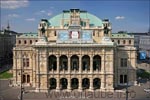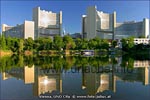|
|
General Information about ViennaBy thinking of Vienna, a lot of classics rapidly come into one's mind that are related to the Austrin capital or its history: Sisi, Kaiserschmarrn (cut-up and sugared pancake with raisins) and Big Wheel cross one's mind as also Viennese Schnitzel (escalope), Viennese Waltz or the Vienna Philharmonic Orchestra. Maybe these tipycal emblems of Vienna appear a little stereotyped at first sight, but by having a deeper look they do not stand for their own but represent an illustrious world of welltried traditions that still today could keep a well established place in the Vienna of today with all its modern developments and continuously fascinates its visitors. But before we do a ramble and get an overview of the world of castles, museums and cultural centres in Vienna on this page, I first would like to mention some general numbers and facts about the capital of Austria: Numbers and Facts about the City ViennaVienna is not only the Federal Capital of Austria, but it also counts to the 9 Federal States of Austria. In dit, with its surface of a little more than 400 km², Vienna is the smallest of all Federal States, but with more than 1,6 million inhabitants, it is the most inhabitated city of Austria. Based on the number of inhabitants, Vienna is therewith no. 15 of the European big cities. As comparison, Berlin is, for example no. 5 with 3,4 million inhabitants and Hamburg with 1,7 million inhabitants no. 11 on the list. But compared to the metropolis Paris, London or Moskau with each approximately 10 million inhabitants, Vienna is rather a small city. 
Vienna is subdivided in 23 districts. Based on the first district in the core of the centre of Vienna that is called Innere Stadt (inner city), the other city districts are located around it forming a circle. The best way to orientate oneself in the city is by considering the numbers of the city districts and not their names. This is due to the reason that the people of Vienna barely use the historically originated names and if they are asked for a sightseeing they assign one to the "second" or "third" district rather than using their names "Leopoldstadt" or "Landstraße". The meaning of Vienna within Austria gets obvious by placing the 1,6 million inhabitants against the approximately 8,5 million of the whole of Austria. This means that approximately every 5th Austrian lives in the city of Vienna. For many people of Vienna, Austria is equal to Vienna, and of course, the inhbitants of the rural areas of Austria dislike this. Imperial World of Habsburg
No matter if the centre of Vienna is explored on foot, by tram or the fiaker (cab): the arquitecture of Vienna is marked by the royal world of Habsburg. Imposing castles, representative seats of government, dapper gardens, laboriously arranged churches are not only relicts but appear in a way as this world was still within so.'s grasp. Once one stepped in into the Hofburg or the Sisi-museum, one is caight by this royal atmosphere that still previls in Vienna. Those who visit Vienna cannot avoid the Habsburg. It is just the opposite, one wants to take as much impressions of Sisi, King Franz and this traditional family history as it is possible home. As already mentioned, more than enough coulisses are available for this. Beside the royal Hofburg, the castle Schönbrunn or the castle Belvedere are further highlights for getting interested to the comprehensive history of the Habsburg. Vienna: World Metropolis of the MusicAs significant as the history of the Habsburg is the reputation of the musicians of Vienna who set a milestone in the 17th century for a music direction that still today is world famous and very popular. I am talking about the music genius Wolfgang Amadeus Mozart and Joseph Haydn, who marked the style of the classic of Vienna and played themselves into the heart of the audience of Vienna with some new composed string quartetts and symphonies. With the move of Ludwig van Beethoven from Bonn to Vienna, the classic of Vienna was supposed to find its perfection and a further development to the romance. 
Johnn Baptist Strauss, born in the year 1804 in Vienna, opened up a very different music era. With his more than 100 waltzs and his apparently most famous work, the Radetzky March, he stayed alive up to date beyond the borders of Austria. But by having a close look, one notices that it is not the music of long ago deceased composers that brings Vienna up today to world renown. It is rather the reputation of the State Opera House of Vienna and the capacity of the Vienna Philharmonic Orchestra that cause a worldwide furore. State Opera House of Vienna is one of the most famous opera houses of the world; top stars of the international opera scene perform regularly in Vienna. But also symhony concerts, chamber music and one-man shows of famous artists are very abundant in Vienna. The International Political Significance of Vienna
The international significance of Vienna is not only relected in the music scene. As the tenth biggest city of the EU of this year, Vienna is since the year 1979 one of the four official residences for the activities of the United Nations beside New York, Geneva and Nairobi. Thereby, Vienna takes a leading position in foreign affairs in regard to international security standards. As a tourist in Vienna, one does not realize much of the contence of these politics, but the VIC, the Vienna International Center, transmits a little big city feeling of New York to the visitor. The skyscrapers of the centre that is more kanown as the UNO-city mark the city image of the Danube-city of today. In total, approximately 25 international organisations as for example OPEC, UNIDO or OSZE have their branch in Vienna. Culinary Viands of the Cuisine of ViennaNo matter which of the highlights one decides to visit in Vienna, one thing can be surely not avoided: the cuisine of Vienna - who doesn't love it? Marked by hungarian and specially bohemian influences, specially the sweet cuisine invites to wallow. It is hard to resist the strudel, confections of pastry and dumplings of all kinds. Also the Wiener Schnitzel, Tafelspitz or Gulasch are famous and very popular also beyond the borders of Austria. One can imagine that in a European metropolis as Vienna one does not get these specialities for a bargain. Going out for dinner in the centre of Vienna is expensive and many restaurants in the city centre are already overcrowded with tourists in the early evening. It is a good idea to book a table. 
Copyright 2007-2008: Patrick Wagner, www.tourist-guide.biz |
||